
This article originally appeared in the March/April 2018 issue of the Museum magazine.
The Santa Fe Community Educators Network allows small museums and other nonprofits to have an outsized educational impact across the city and region.
On a warm morning in August 2017, more than 150 teachers returned to their northern New Mexico classrooms with the training and resources they needed to implement eight weeks of after-school programming in topics as varied as computer coding, healthy cooking, the history of trade in New Mexico, and using observation to explore the worlds of art and science.
Skip over related stories to continue reading articleThis hands-on training, which provided lessons and materials, occurred through a unique partnership between the Santa Fe Community Educators Network (SFCEN) and 21 Santa Fe and Española public elementary and middle schools—and represents just one of the ongoing projects SFCEN has undertaken in its first four years. SFCEN is
a diverse working group made up of more than 40 nonprofit organizations and state museums dedicated to meeting the educational demands of the region.
Across the country, education professionals at small nonprofits struggle to collaborate with other organizations. Unfortunately, small organizations are often in direct competition over limited local funding.
In Santa Fe, SFCEN serves as a counterweight to this reality, carving out a space where community educators can come together, learn, share ideas, build on one another’s successes, and innovate in ways that would be impossible on our own. This is the story of how this network formed, how we started working together, and how we continue to grow.
The Birth of the Network
Despite its reputation as a popular tourist destination, Santa Fe is a complex community in one of the poorest states in the country. More than 70 percent of K–12 students in the Santa Fe Public Schools qualify for free or reduced price lunch, 28 percent are proficient in reading, and 17 percent are proficient in math, according to school system data.
KIDS COUNT ranked the state 49th in the nation for child wellness in 2017.
However, the city is rich in culture, found both across our diverse communities and in numerous museums and nonprofits. Many of our institutions are small, typically employing an education staff of one to three people. Tasked with the daunting goal of helping families and schools support children and youth, informal educators across the city realized we needed one another’s support if we hoped to advance our work.
In January 2014, education directors from 10 local museums, gardens, and environmental organizations organized the first SFCEN meeting to talk shop over lunch. Most of us were the only education staff person within our organizations, which can feel isolating.
Five minutes into the meeting it was apparent that we all spoke the same language and were facing similar challenges, from recruiting volunteers to aligning curriculum with Common Core standards. By the end of the first conversation, we had decided to have monthly one-hour lunch meetings, rotating locations so we could visit one another’s institutions.
But SFCEN was not an immediate success. After several well-attended gatherings, summer attendance dwindled to a handful of people. After many one-on-one conversations, we realized that members wanted more than just a space to talk, and we started identifying areas where we could turn talk into action.
Starting Our Collaborative Work
In the beginning, SFCEN members compared programming to identify duplicating services and gaps in K–12 school and summer programming. We also reached out to city and school district offcials to get their input.
As SFCEN member organizations moved from conducting independent, parallel initiatives to creating collective impact programming, we aligned strategies and actions and shared resources and responsibilities. This meant that organizations had to let go of some programming while adding new projects to fill community needs.
For example, before SFCEN, Audubon New Mexico, the Santa Fe Watershed Association, and the Santa Fe Botanical Garden were each working with elementary schools to educate students about local habitats and ecosystems. Some teachers were bringing their students to all three sites, while other students were not getting any outdoor education.
Through SFCEN, the three groups formed a partnership and created an environmental education program for third-, fourth-, and fifth-grade students. Each organization focuses on one grade, offering a week of programming and a field trip.
Fortuitously, just as SFCEN members were beginning to align initiatives, the city of Santa Fe, Santa Fe Public Schools, and the Santa Fe Community Foundation began coordinating their services to alleviate issues facing area youth and
families. As a result of this new alignment, leaders from across the city met to identify specific success outcomes and indicators, including increasing graduation rates, improving reading and math scores, and reducing the number of disconnected youth. The Santa Fe Community Foundation and the city challenged the community to help improve health, wellness, and educational and job opportunities for our youth, from birth to career. They also offered funding to jumpstart initiatives.
These new, better-defined community initiatives helped SFCEN members align our collective programming with specific and measurable goals. In 2015, the Santa Fe Community Foundation’s Birth to Career Collaboration awarded SFCEN a $2,000 grant to provide professional development for members. SFCEN used the grant to fund a day-long workshop on outcomes-based evaluation so that we could approach project evaluation from a similar perspective and speak a shared language.
Perhaps as important as the training was the symbolic effect of the grant; this relatively small infusion of money provided a stamp of approval from the Community Foundation and legitimized SFCEN’s work with a broader audience. Our membership increased dramatically, along with interest in our programming. This quickly led to another major milestone for the group: our first teacher resource fair in the fall of 2015, coordinated with Santa Fe Public Schools.
After learning that teachers had been struggling to find outside educational opportunities for their students, more than 40 of SFCEN’s partner organizations gathered at the New Mexico Museum of History and Palace of the Governors for the first teacher resource fair. This event is clearly meeting a need: attendance at our 2017 fair more than doubled from 2016, and the Santa Fe Public Schools superintendent attended to show support and connect with each participating organization. Through this annual event, informal educators have developed meaningful relationships with public school educators, which have helped strengthen the Santa Fe education system.
Impressed by our group’s impact and reach in the 2015–16 school year, the Community Foundation’s Birth to Career Initiative increased SFCEN funding to $12,000 each for 2016–17 and 2017–18. These increased funds have allowed us to dramatically expand our collaborative programming and plan for the sustainability of the network. We hired a
consultant to help build a succession plan, increase capacity, define a shared leadership structure, and set effective meeting routines.
“The list of things [SFCEN] has accomplished is ever-expanding, and their initiatives have directly impacted the lives of children in our community for the better,” says Katherine Courtney, director of collective impact initiatives for the Santa Fe Community Foundation. “We are proud that they are a part of Opportunity Santa Fe: Birth to Career.”
How Our Work Has Grown
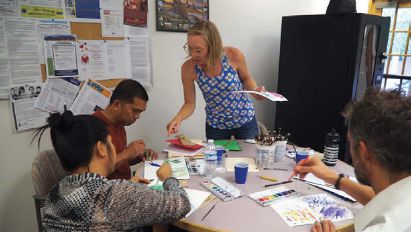
Every SFCEN member is a critical piece of the network, but three lead organizations facilitate communications
between SFCEN and the Community Foundation: the Georgia O’Keeffe Museum, Santa Fe Botanical Garden, and SITE Santa Fe. Educators from these three organizations are responsible for grant writing and reporting and managing the group’s finances. The steering committee organizes the monthly meetings, sets the agenda, and communicates with presenters.
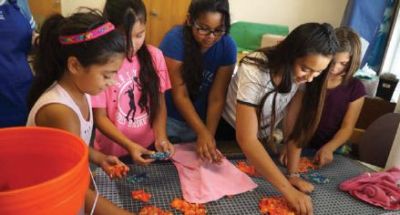
Botanical Garden and Museum of International Folk Art to explore the properties of plants.
Subcommittees organically form around shared goals, resulting in unified projects like Creative Collaborations, which is spearheaded by SITE Santa Fe. Through this initiative, nonprofits, teachers, and creative professionals came together in a classroom for eight sessions to share expertise and resources on working with middle school youth. (Find out more about this initiative at the Annual Meeting & MuseumExpo in Phoenix, Arizona, May 6–9.)
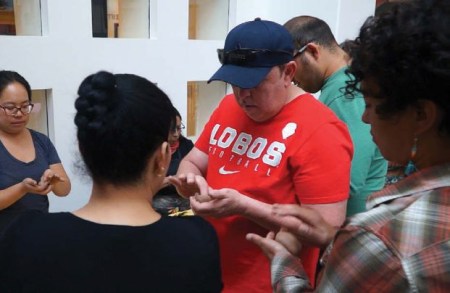
A second project emerged when Adelante, a nonprofit that serves immigrant and homeless populations, requested family programming after its free weekly dinners. SFCEN member organizations, coordinated by the Georgia O’Keeffe Museum, now take turns providing that programming, which has included juggling, plate balancing, and other circus activities, presented by Wise Fool New Mexico; a flower-themed evening co-organized by the Santa Fe Botanical Garden and the Georgia O’Keeffe Museum; and activities exploring the history of New Mexico, presented by the New Mexico History Museum/Palace of the Governors. Sharing this responsibility across dozens of institutions has made a major impact on the community without overly taxing any individual group.
And our work with Adelante has grown. When SITE and the Botanical Garden learned that Adelante did not provide any summer programming due to a lack of funding, SITE worked with an exhibiting artist to provide drawing and industrial design programming for Adelante families, hosted at the Botanical Garden. The groups also provided the Adelante community with stipends for participants, Spanish translation, food, and meaningful summer learning opportunities.
This type of responsiveness has fueled SFCEN’s growth in 2017: a community need becomes apparent, partnerships naturally materialize, and solutions grow and flourish. In fact, SFCEN is successful because partners allow unexpected projects to emerge due to the alchemy that occurs when multiple individuals bring diverse resources to work toward a common goal.
“I wish I’d had the opportunity as a kid to participate in innovative programming with organizations like SITE Santa Fe or learn about water conservation with the City of Santa Fe Water Conservation team,” says Molly Timmins, AmeriCorps VISTA leader supporting Opportunity Santa Fe. “Our community is better o because of the Santa Fe Community Educators Network’s commitment to and love for the community and youth that make up Santa Fe.”
Shannon Bay is the education program manager at the Georgia O’Keeffe Museum, Joanne Lefrak is the director of education and curator of public practice at SITE Santa Fe and the chair of the City of Santa Fe Children and Youth Commission, and Mollie Parsons is the education director at the Santa Fe Botanical Garden and a former classroom teacher. They will discuss other aspects of the Santa Fe Community Educators Network at the 2018 Annual Meeting & MuseumExpo in Phoenix, Arizona, May 6–9.
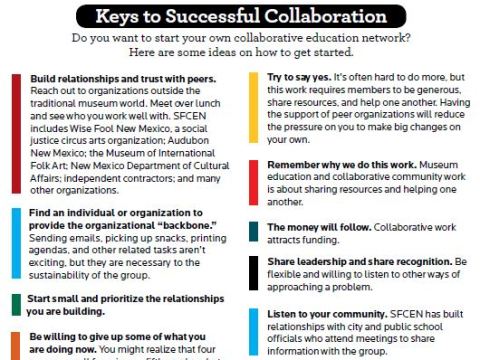
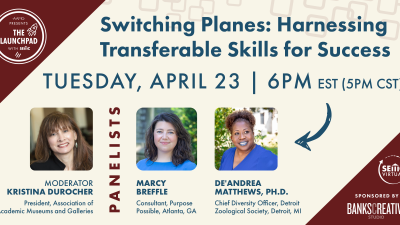





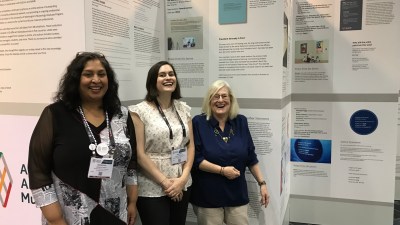
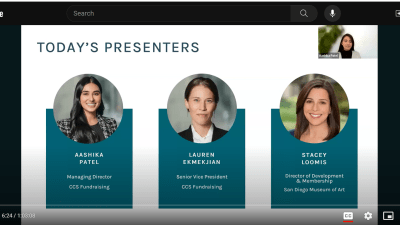
Comments